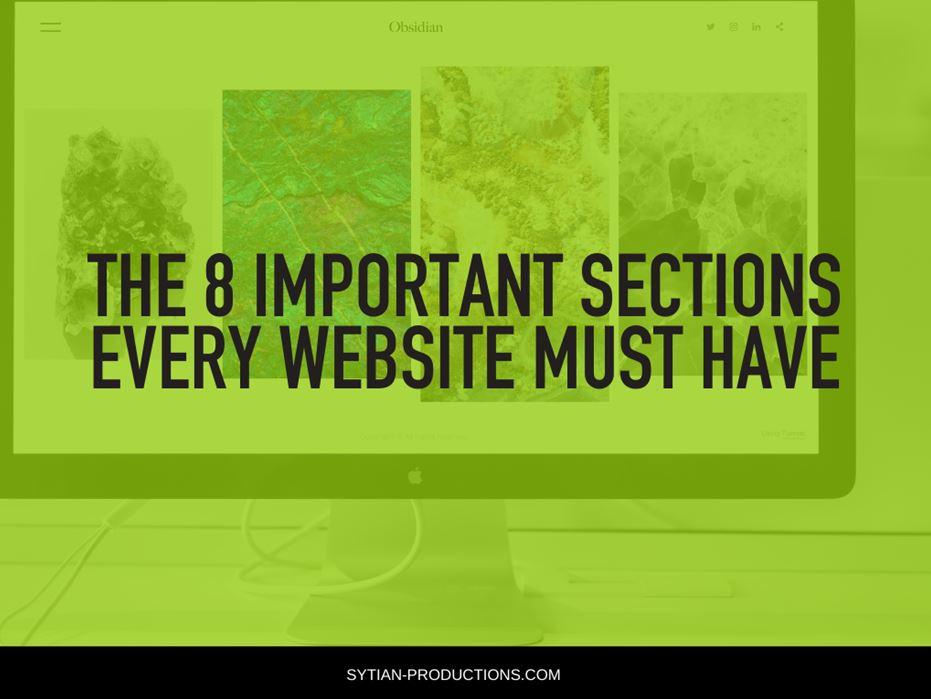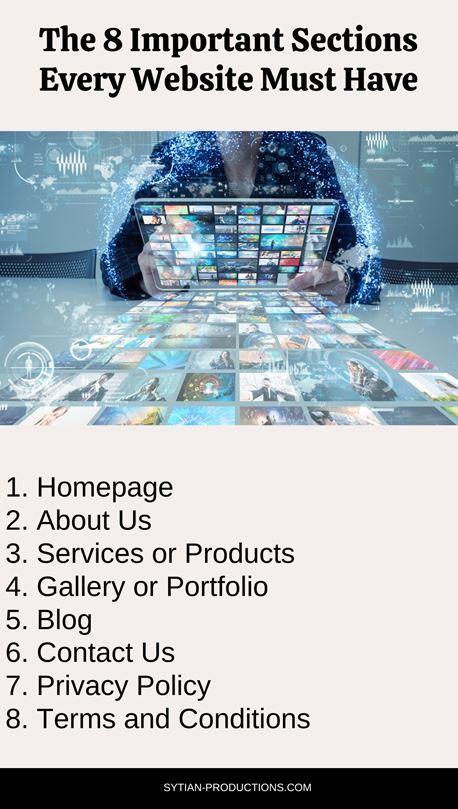8 Important Sections Every Website Must Have

When you’re starting a website, there are a few things you need to keep in mind. One of the most important is the sections your website will need. Not every website will require all of these sections, but most will need at least some of them.
Here are the 8 most important sections every website must have:

1.) Homepage:
The homepage is your website’s main page. This is where your visitors will start when they visit your website. The homepage should be attractive and engaging, and it should quickly introduce your business to your visitors.
Here are some tips on how to make a converting homepage.
- Make it very clear to explain what you offer. Include a strong headline and make sure your visitors know what your website is about.
- Include a call to action. Your homepage should include a call to action, such as a button or a link that encourages your visitors to stay on your website and learn more.
- Make it visually appealing. Your homepage should be visually appealing so that your visitors will want to explore it further. Use attractive images, typography, and layout to keep your visitors engaged.
Related reading: 10 HomePage Elements Every Website Should Have
2.) About Us
The about us section is a great place to tell your visitors more about your company and what you do. This is a good place to share your company history, mission statement, and values.
People are concerned about who they’re doing business with, which is why sharing your story and “why you do what you do,” may make a significant impact when attempting to attract new clients.
A well-written “About Us” section on your website can tell your company’s history, discuss your purpose, and set goals for the future. Consider including information about the company’s founders, present management executives, and more.
Here are some tips on how to create a killer About Us Page:
- Include behind-the-scenes photos of your team. Your visitors will love getting to know the people behind the company.
- Write in a friendly, informal tone. This is your opportunity to connect with your visitors on a personal level.
- Include customer quotes. Nothing builds trust like customer testimonials.
3.) Services/Products
The services or products section is where you can list the services or products that your company offers. This is a great place to include detailed information about each service or product, as well as pricing information and photos.
Your services or products section should be easy for your visitors to navigate. Make sure each service or product has its own page with clear headings and concise descriptions.
Here are some tactics you can include when creating a product page:
- Include high-quality photos of your services or products. Your visitors will want to see what you offer before they decide to buy.
- Include pricing information. Your visitors will appreciate knowing how much your services or products cost upfront.
- Include a video demonstration. A video demonstration can be a great way to show your visitors what your service or product is all about.
4.) Gallery/Portfolio
The gallery or portfolio section is a great place to showcase your work. This is a good place to include photos of your past projects, as well as testimonials from clients.
Your gallery or portfolio section should be easy for your visitors to navigate. Make sure each project has its own page with clear headings and concise descriptions.
Here are some tips on how to create an effective portfolio:
- Include high-quality photos of your work. Your visitors will want to see your work before they decide to hire you.
- Include client testimonials. Nothing builds trust like a positive review from a past client.
- Include social media buttons. Your visitors will appreciate the ability to easily share your work with their friends and followers.
- Find a layout that fits your brand’s personality. Make sure your portfolio reflects your company’s unique branding.
5.) Blog
The blog section is a great place to share your thoughts and insights on your industry. This is a good place to post articles about current trends, case studies, and more.
Your blog section should be easy for your visitors to navigate. Make sure each post has its own page with clear headings and concise descriptions.
Here are some tips on how to maintain an effective blog:
- Create effective headlines/titles. Your blog posts will be more likely to be read if the headline is catchy and interesting.
- Include images. Images can help to break up the text and make your blog posts more visually appealing.
- Include social media buttons. Your visitors will appreciate the ability to easily share your content with their friends and followers.
- Make it easy to read. Your blog posts should be easy to read, with short paragraphs and plenty of whitespaces.
- Keep a posting schedule. A regular posting schedule will help you to keep your blog updated and interesting.
6.) Contact
The contact section is a great place for your visitors to find out how they can get in touch with you. This is also a good place to include your company’s mailing address and phone number.
Your contact section should be easy for your visitors to navigate. Make sure each method of contact has its own page with clear headings and concise descriptions.
Here are some tips on how to create an effective contact section:
- Include an online contact form. This is the easiest way for your visitors to get in touch with you.
- Include your company’s mailing address and phone number. Your visitors may need to send you a letter or call you for more information.
- Make it easy to find. Your contact section should be easy to find on your website.
7.) FAQ
The FAQ section is a great place to answer your visitors’ most common questions. This is a good place to include information about your company, products, and services.
Your FAQ section should be easy for your visitors to navigate. Make sure each question has its own page with clear headings and concise descriptions.
Keep it updated. Keep your FAQ section up-to-date with the latest information about your company, products, and services.
8.) Social Media
The social media section is a great place to connect with your visitors on the web’s most popular social networks. This is a good place to include links to your company’s profiles on Facebook, Twitter, LinkedIn, and more.
It may be difficult to create a successful website, but with these eight pointers, you’ll be well on your way. Remember to keep your website updated with the latest information about your company, products, and services. And most importantly, make sure that your website is reflective of your brand’s personality!